The project to replace Lincoln High School with a new 6-story building is working its way through the Design Advice Request (DAR) process. Three meetings in front of the Design Commission have been held to date, with the most recent in February. The new campus is being designed by Bora architects and Mayer Reed landscape architects.
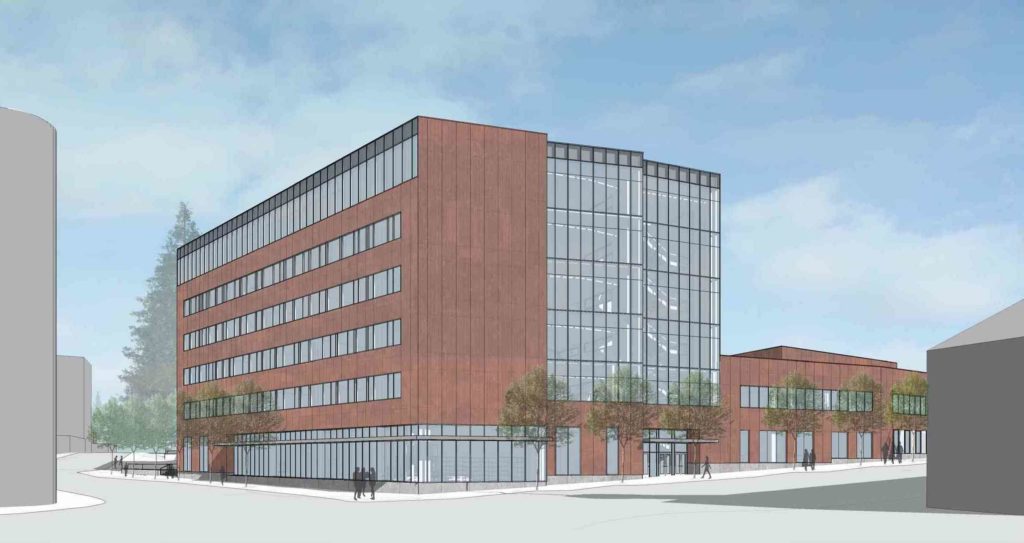
The Lincoln High School campus is located in Goose Hollow, on an 11 acre super block bound by SW 18th Ave, SW Salmon St, SW 14th Ave and adjoining properties on SW Jefferson St and Madison St.
Under the proposed rebuild the new school will be located at the western portion of the site, fronting SW 18th Ave. The existing 1952 school building at the east of the site will remain in use during construction. Once the new school building is complete the existing building will be demolished, allowing for the construction of a track and field.
A north-south pedestrian/bike connection through the site on alignment with SW 17th Avenue would be created, between the new building and the athletic field. The new connection would be open to the public, outside of school hours.
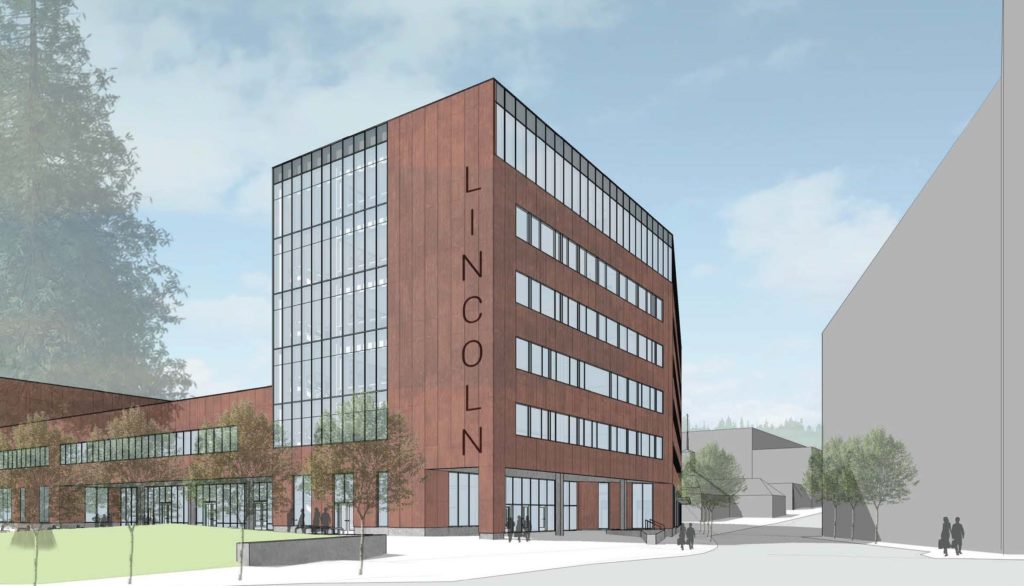
A 6-story classroom tower will be located at the corner of SW 18th & Salmon, across the street from a recently approved apartment building. The main entrance will be from an entry court located at SW 17th and Salmon. Drop off and pick up activities will continue to happen on SW Salmon St.
Larger volume spaces, including the school’s theater and athletics facilities, will be located in a lower rise structure, which extends along SW 18th Ave to the south west corner of the site.
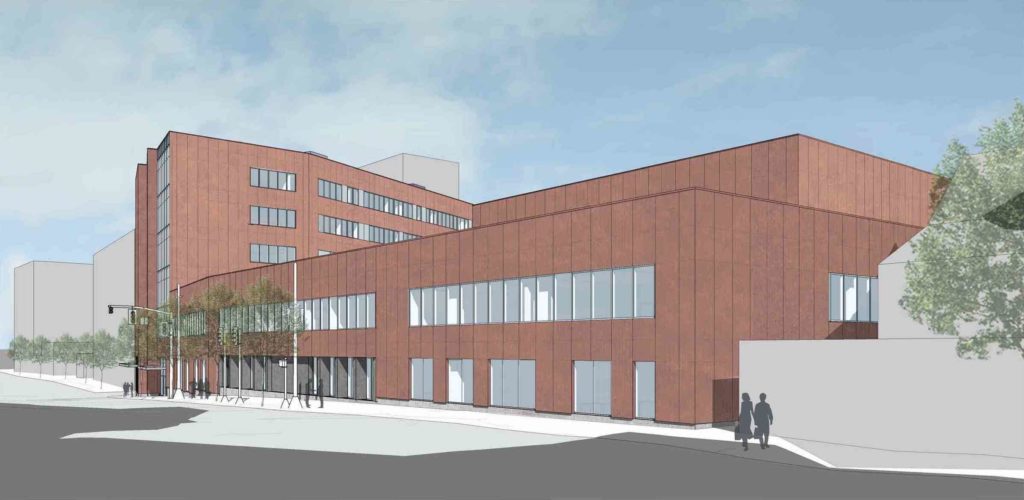
At the time of the February 7th Design Advice Request the choice of exterior materials had no yet been determined, however red TAKTL concrete or SwissPearl panels were being investigated as an option.
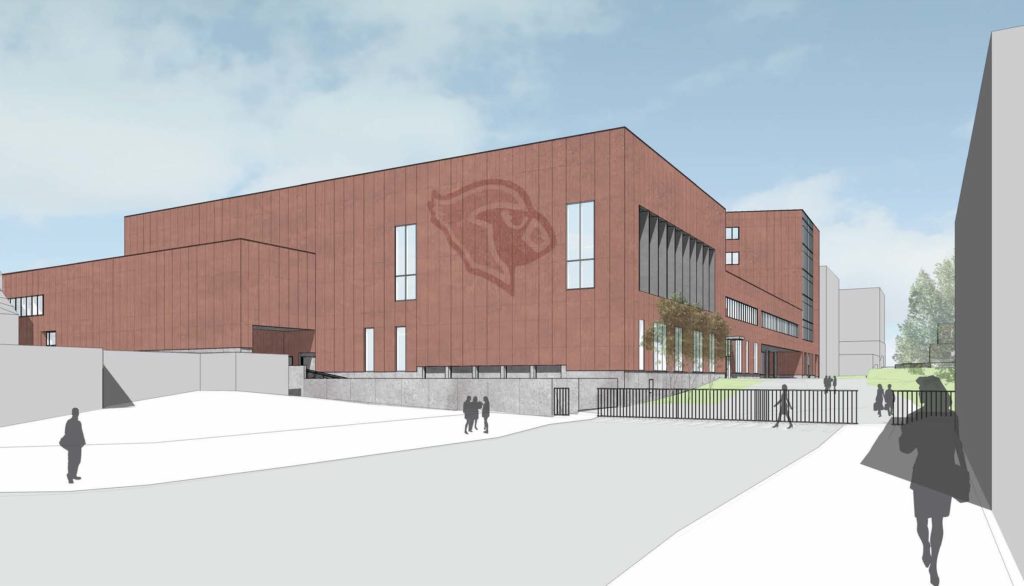
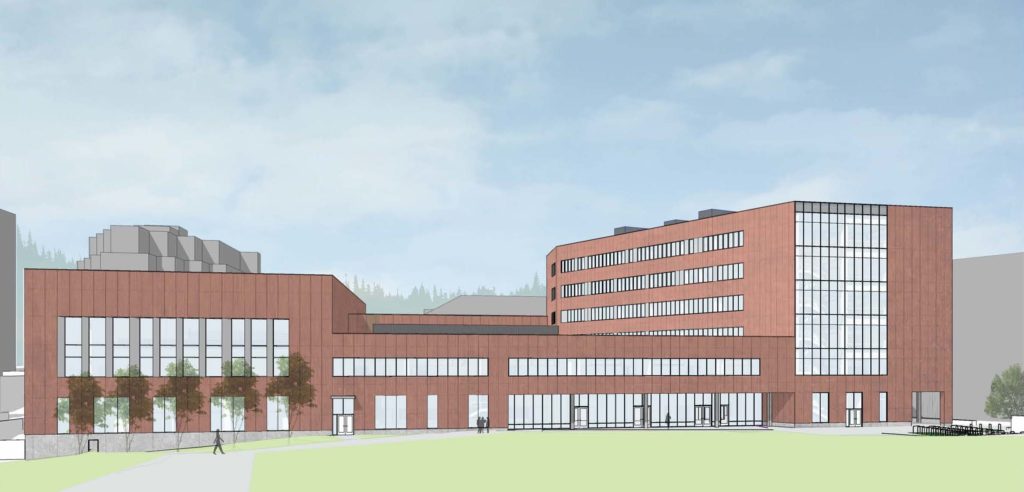
Issues discussed at the third DAR, and described in a summary memo, included: the building context, including the design of the north-south path and the entry plaza, which the Commission indicated needed refinement; the public realm, including ground floor program, which was applauded; and the building composition, which was praised in general, with the need for more articulation and finer grain scale noted.
A fourth DAR is scheduled for this coming Thursday, May 16th, where updated designs will be presented. In order to gain approval the project will have to go through a Type III Design Review, with public hearings in front of the Design Commission.
Drawings
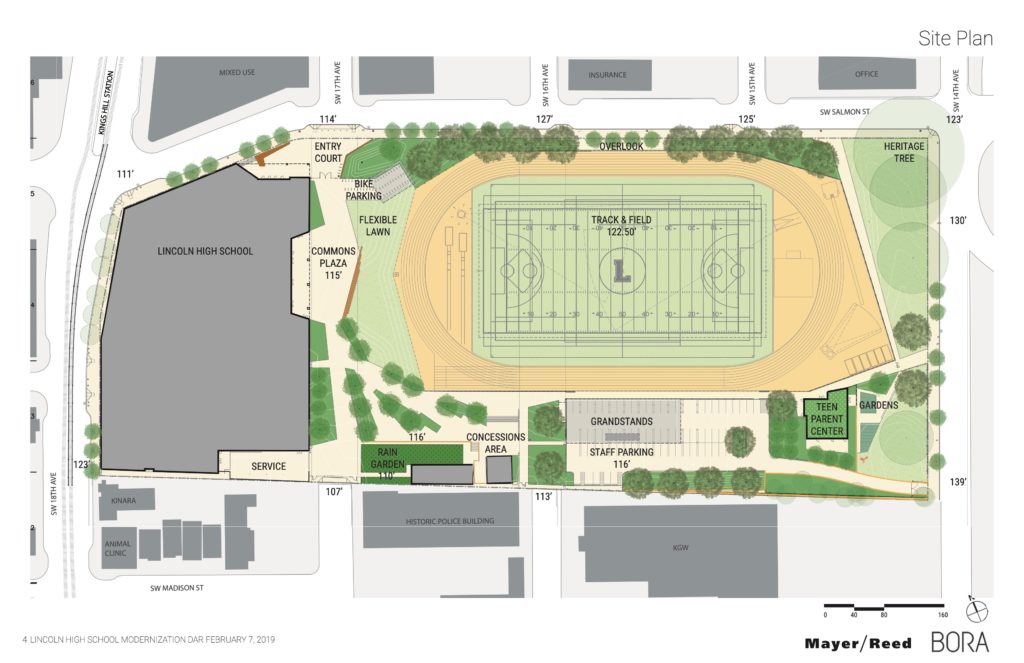
Plan | Site 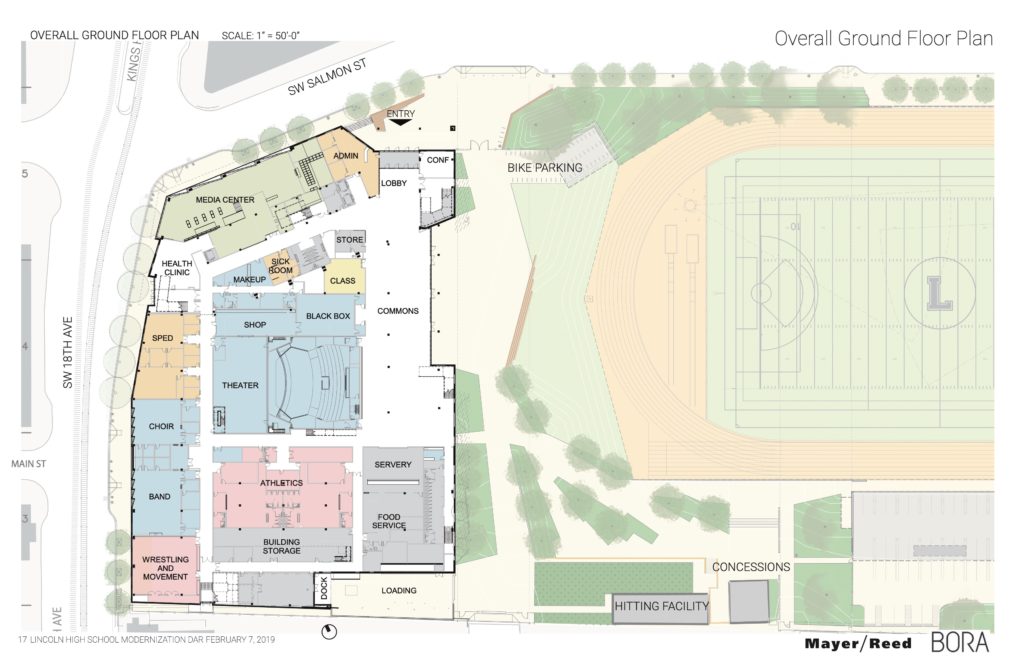
Plan | Ground
This could be worse. It will be nice to have building frontage on 18th instead of the grungy overgrown fenceline there today. I’m disappointed that this project, like the one across the street, is removing the large tree at the corner of 18th and Salmon; I do wish both projects had found a way to retain their respective trees. And, at least from the drawings shown, it doesn’t appear that they’re proposing to widen the sidewalk on 18th, though it’s sorely needed. I do like the new curb extensions shown at the intersections on Salmon, though the ones at 15th and 16th could/should cover both sides of the intersection like the one at 17th.
My main concern is that they’re going to define “school hours” as something ridiculous like 6am-9pm M-F, and also designate chunks of the weekend as off-limits because sports, effectively making the public access on 17th a farce. I still think that the fencing on the 17th alignment, if they insisted on having it, should be aligned north-south, so that the field area and the building could be separately closed up while leaving 17th open at all hours. Instead, they’re essentially creating an 11-acre fortress that will feel more like an unwelcoming private campus.
Does anyone know the rationale for closing off 17th Avenue even during school hours?
As a teacher my guess is that it has to do with meeting whatever new school security “best practices” are being promoted by the whole new industry of school security consultants that have cropped up post-Columbine. There’s shelter in place, lock downs, lock outs, lock ins, active shooter drills, and I don’t know what all nonsense being propagated these days. Easier just to close off the whole perimeter of the school as security theater than actually doing anything sensible about guns.
Thanks, Kent; that was my fear. Despite the dramatic outbursts of shootings like Columbine, violent crime in the U.S. in general has fallen dramatically over the past four decades. There is a tradition of treating schools either as prisons to keep students in, (see: “The Same People who Designed Prisons Also Designed Schools” https://www.archdaily.com/905379/the-same-people-who-designed-prisons-also-designed-schools), or as fortresses to keep the dangerous, interfering world out (See Burbank High School in L.A. and Columbia University in New York City).
There is, of course, an alternative perspective that views secondary education as integral to a thriving democracy and city, and thus promotes an architecture of transparency and urban integration. Over past decade or so, an excellent example of building an environment with this approach in mind is Portland State University, where a vibrant campus has been created that invites citizens to visit and students to interact with their city.
I do tend to agree with you. Although I have worked at some older suburban HS campuses that were designed in the 1970s with open buildings with exterior classroom doors and open plazas all over the place. It can be annoying and insecure when you have too many people walking through with loose dogs and such and too many druggie types trying to creep onto campus to do deals. Or the 19 year old recent drop outs lurking around trying to hook up with 15 year old freshmen. Less frequent but still problematic are the freaky non-custodial parents trying to creep onto campus to interact with kids in violation of some restraining order. That sort of thing. So, school shootings aside, there are very real mundane daily reasons to keep school campuses relatively secure. Doesn’t mean they need to be fortresses though. Just have reasonably controlled access points.
Thanks, Kent, for the practical reasons for controlling access to high school buildings. I do wonder, however, how Grant H.S. solves the security problem. Its campus is very open and even abuts Grant Park on two sides.
How to design an urban school, see GEMS Academy, Chicago
I should have added the current design resembles a 50s YMCA.
West side gets a brand new school while east side kids don’t have pencils. Seems fair.
Umm Grant is completely being remodeled, Roosevelt got completely remodeled, Franklin got completely remodeled, Madison and Benson are next as well.. sooo what are your talking about ?
David: Grant is being remodeled. With these old schools designed 100 years ago you just kludge through and do what you can to accommodate them to modern standards such as security, ADA, seismic standards, lab spaces, etc. etc. I sometimes work at Mountain View HS in Vancouver. I think they used some off-the-shelf plans from Southern California back in the 70s when they built that school because every classroom opens to outdoor courtyards and breezeways with various buildings scattered about a campus. Ridiculously insecure and energy inefficient. No way to really secure the school. One would never design a school like that today. But they kludge through until the school is finally replaced which it is scheduled to be in a year or so.
But that doesn’t mean you follow old design templates when building new schools like Lincoln.
Kent, I get that the school buildings need to control accessibility, but what I’m less clear about is the permeability of the surrounding grounds. Surely security concerns are incorporated into the very expensive remodel of Grant, and yet so far I see no evidence of barriers that would separate the campus from the public sidewalks and adjacent park. This suggests that easy student-public interaction outside the buildings will continue. And certainly PSU has made efforts to BETTER connect with the surrounding public realm as seen by the street car stops on campus, turning over most of the campus to the food market on Saturdays, the creation of new entrances along Broadway when remodeling old buildings, and devoting significant ground floor space to retail uses in some remodels and new construction.
Based upon the drawings and description above, I’m not sure how fortified the envisioned Lincoln campus will be. Although the creation of a pedestrian & bike path on 17th Avenue is a step in the right direction, I think it’s probably a mistake to close it off during school hours, especially if this closure encompasses the entire super block. During school hours parts of the campus could serve as a welcomed green space for preschoolers, retirees, and others.
I don’t think schools are trying to fortify themselves. But I do think there is a greater focus on controlling access through a smaller number of points than might have been the case in decades past. Most schools these days are going to try to funnel all visitors through some sort of checkpoint where IDs can be checked and so forth.
You can’t really compare high schools and universities. At a HS the administration is responsible for 1000+ minors who are apt to do all kinds of crazy things. At a university it is all adults. Completely different situation.
There is also a big difference between urban schools with lots of pedestrian traffic and big suburban campuses where the schools are set back and accessed primarily by cars.
All I am saying is that I suspect that the closing off of Lincoln’s campus is in response to security concerns and the architects and school district is no doubt dealing with school security consultants these days who are pushing to close the place off and restrict access. There are a bazillion companies and consultants these days trying to sell every imaginable software, hardware, and architectural solution they can invent to “solve” the issue of school security. That sort of thing barely even existed pre-Columbine.
Grant had an entire security assessment done. It’s pretty creepy to read. They’ve definitely thought about it in the new design, and it improves some of the choke points in the old design that would aid shooters in confining students.